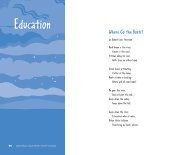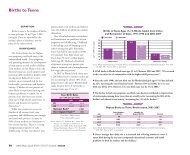2010 Rhode Island Kids Count Factbook
2010 Rhode Island Kids Count Factbook
2010 Rhode Island Kids Count Factbook
Create successful ePaper yourself
Turn your PDF publications into a flip-book with our unique Google optimized e-Paper software.
Housing and Health<br />
DEFINITION<br />
Housing and health is the percentage<br />
of children under age 18 who live in<br />
low-income families that reside in older<br />
housing, defined as housing built before<br />
1980. Low-income families are those<br />
with incomes less than 200% of the<br />
federal poverty level.<br />
SIGNIFICANCE<br />
Healthy child development requires a<br />
home that is well-built, free of toxic<br />
hazards and that provides a place to eat<br />
well, play safely, and sleep soundly.<br />
Housing quality affects children’s ability<br />
to grow, think, learn, relax, and form<br />
critical early bonds. 1<br />
Unhealthy housing can cause or<br />
intensify many health conditions.<br />
Children living in homes built before<br />
1978, when lead paint was banned from<br />
interior use in the United States, are at<br />
risk for lead poisoning. Studies have also<br />
connected allergies, respiratory distress,<br />
asthma, unintentional injuries,<br />
poisoning, cancer, and heart disease to<br />
poor quality construction, inadequate<br />
maintenance, and unhealthy<br />
behaviors. 2,3,4,5<br />
Adopting a comprehensive “healthy<br />
homes” approach that includes both<br />
education and physical interventions<br />
can help prevent housing-related<br />
injuries and illnesses, reduce health costs<br />
010<br />
90<br />
80<br />
70<br />
60<br />
50<br />
40<br />
30<br />
and improve children’s quality of life.<br />
20<br />
Because the causes of many health<br />
Children Living in Older Housing*, 2006-2008,<br />
10<br />
conditions related to the home<br />
<strong>Rhode</strong> <strong>Island</strong> and the United States<br />
0<br />
environment are interconnected, it can<br />
Low-Income Children All Children<br />
be cost-effective to address multiple<br />
100%<br />
hazards simultaneously. 6 For example,<br />
90%<br />
80%<br />
86%<br />
repairing cracks in a home’s foundation 70%<br />
60%<br />
74%<br />
can help keep both water and pests<br />
50%<br />
62%<br />
54%<br />
from entering the house and would<br />
40%<br />
30%<br />
address multiple asthma triggers –<br />
20%<br />
10%<br />
mold, cockroaches and rodents.<br />
0%<br />
Similarly, most lead programs that<br />
<strong>Rhode</strong> <strong>Island</strong><br />
United States<br />
repair painted surfaces containing lead Source: Population Reference Bureau analysis of 2006-2008 American Community Survey (ACS) Public Use<br />
Microsample (PUMS) data. *Older housing is defined here as housing built before 1980. The ACS reports data on<br />
also fix the leaks that caused the paint<br />
the year a housing structure was built by decade, so this is the best available approximation for housing built before<br />
to peel in the first place. Fixing the leaks 1978 (when lead paint was banned from interior use in the United States).<br />
helps the lead repair last longer and also<br />
◆ In both <strong>Rhode</strong> <strong>Island</strong> and the nation as a whole, children in low-income families are<br />
prevents mold problems.<br />
more likely to live in older housing than children in general. Between 2006 and 2008,<br />
The quality of children’s homes<br />
86% of low-income children in <strong>Rhode</strong> <strong>Island</strong> lived in older housing, while 74% of all<br />
and surrounding neighborhoods are<br />
children lived in older housing. Of all 50 states, <strong>Rhode</strong> <strong>Island</strong> has the highest percentage<br />
important to their development. Lack<br />
of low-income children living in older housing.<br />
of affordable housing puts safe, healthy,<br />
8<br />
well-maintained housing out of reach<br />
◆ <strong>Rhode</strong> <strong>Island</strong> children were more likely to live in older housing (74%) than children<br />
for many families, forcing families to<br />
in the nation as a whole (54%). <strong>Rhode</strong> <strong>Island</strong> has the second highest percentage of<br />
raise their children in overcrowded and<br />
children living in older housing in the nation, after New York.<br />
unsafe environments that can interfere<br />
9<br />
with their growth and development.<br />
◆ <strong>Rhode</strong> <strong>Island</strong>’s older housing stock poses additional health risks for children because,<br />
Overcrowded housing is associated with<br />
until 1978, lead paint was commonly used in the interior and exterior of homes, and<br />
feelings of helplessness, delayed<br />
exposure to lead paint is associated with numerous risks to child health and development.<br />
cognitive development, and behavioral<br />
10,11<br />
problems among children. 7 ◆ Because affordable housing is in short supply, many low-income families must choose<br />
between poorly-maintained housing that puts the health and safety of their families at<br />
risk and housing that is safer but unaffordable. 12 When available housing costs more than<br />
a low-income family can afford to pay, they are unlikely to have the discretionary income<br />
needed to maintain, repair, or improve their homes. 13<br />
76 <strong>2010</strong> <strong>Rhode</strong> <strong>Island</strong> KIDS COUNT <strong>Factbook</strong> / Health






